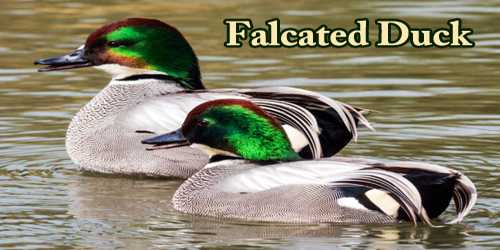Falcated Duck (Anas Falcata), also known as the ‘Falcated Teal’ or “Bronze-capped Duck” is a gadwall-sized dabbling duck from the East Palearctic (East Siberia and Mongolia to North Japan; wintering to India). This Duck breeds from southern Siberia to northeast China, Korea, and northern Japan, wintering to southern Japan, east and south China, and Vietnam. It is a rare vagrant to the Aleutian Islands and rarer still along the Pacific Coast of North America. The closest relative of this species is the gadwall, followed by the wigeons. The species was assigned to the proposed genus Mareca after its previous placement in the genus Anas was found to be paraphyletic in 2009. This dabbling duck is strongly migratory and winters in much of Southeast Asia. In India: Uttar Pradesh, Bihār, Assam, eastern Haryāna. Also in northern Bangladesh, northern and central Myanmar, northern Laos to the Mekong River, northern Vietnam (from about Hanoi north), and China: Hainan, Taiwan, Yunnan, Guangxi, Guangdong, Fujian, Jiangxi, northern Hunan, Hubei, Zhejiang, Anhui, Jiangsu, Shandong, southern Hebei, Shanxi, northern Shaanxi. It is gregarious outside the breeding season and will then form large flocks. It is estimated that there are about 89,000 falcated ducks in total; this is much higher than the previous population estimate of 35,000 worldwide.
Falcated Ducks name originated from the elongated, sickle-shaped, black and white ornamental inner secondary’s that droop over the flanks, and even reach the water in swimming drakes. Males have got a peaked forehead and a long, shaggy, silky, bronzy-green to chest-nut-purple crest and mane. The shimmering iridescent crest cascades onto the back, hence their neck appears extremely thick. Even in flight, the ducks appear squat and short-necked, with disproportionately large heads. Females of Falcated Duck (Anas Falcata) are slightly more brownish overall, with darker heads, and they have green-and-black speculums. They breed in southeastern Siberia and northeastern Mongolia east to Hokkaido in northern Japan. They are capable divers which normally forage in the water near emergent vegetation. Pairs breed within the forest limits, chiefly in river basins or near lakes. During the summer breeding season, found in wetlands and wetland margins around water bodies such as lowland lakes and ponds. They use similar habitat in winter, but can also occasionally be found in saltwater estuaries and lagoons. The falcated duck has a large range, with an estimated global extent of occurrence of 1,000,000–10,000,000 km2 (390,000–3,860,000 sq mi).
Falcated ducks have food habits generally consisting of small invertebrate and other insects as well as plant foods. They mainly eat vegetation or insects near to the water, consuming animals such as larvae, crustaceans, and mollusks. They likewise eat plant foods: leaves as well as seeds, grains, and nuts. Many assume that the falcated duck helps disperse seeds over large areas because of their diet. These ducks are primarily herbivorous. These ducks prefer river oxbows and small lakes featuring a mixture of open and wooded cover. Laid during May and June their eggs are deposited in well-constructed nests concealed in tall herbage, or beneath bushes on wet, marshy ground. Falcated Ducks (Anas Falcata) tend to fly in formation when engaged in long-distance flights. The stunning ducks are extensively hunted in China for food and their ornamental feathers. Due to their exquisite ornate plumage, the ducks are extremely popular with aviculturists.
















